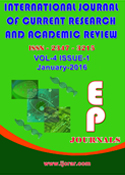Abstract Volume:4 Issue-1 Year-2016 Original Research Articles
 |
Online ISSN : 2347 - 3215 Issues : 12 per year Publisher : Excellent Publishers Email : editorijcret@gmail.com |
Sesame is grown predominantly in Kharif with low productivity. To increase productivity by minimizing environmental effects, the better management option is to grow it in summer. Hence, to decide appropriate date of sowing and row spacing, an experiment was conducted with three sowing dates (D1=1 st February, D2=15th February and D3=1st March) and three row spacings (S1= Broadcasting, S2= 30x 10 cm and S3= 45x10 cm) for three years. Consistent results were obtained over the years. Reduction in vegetative duration (VD) and reproductive duration (RD) was observed due to delay sowing. Date of sowing also affected the growing degree days (GDD) during VD and RD. Decreased GDD for RD with delay sowing was related to reduction in length of RD. Early or late sowing than 15 th February adversely affected the seed yield. Average yield advantage of 15 th February sown crop was 151.7% and 10.1% higher over early and late sown crop, respectively. Yield attributing traits also revealed maximum expression in 15 th February sown crop. Spacing treatments differed significantly for seed yield. The highest seed yield was gained at 30x10cm spacing to the tune of 13.6% and 15.4% higher over broadcasting and 45x10 cm spacing, respectively. Sowing of sesame on 15 th February at spacing of 30x10cm is recommended for sustainable cultivation in semi-arid environments with high economic benefit.
How to cite this article:
Bachubhai A. Monpara and Devshibhai R. Vaghasia. 2016. Optimizing Sowing Time and Row Spacing for Summer Sesame Growing in Semi-arid Environments of IndiaInt.J.Curr.Res.Aca.Rev. 4(1): 122-131doi: http://dx.doi.org/10.20546/ijcrar.2016.401.011



Quick Navigation
- Print Article
- Full Text PDF
- How to Cite this Article
- on Google
- on Google Scholor
- Citation Alert By Google Scholar
